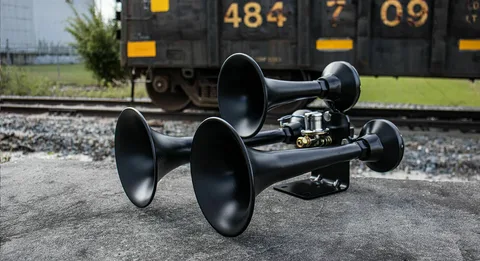Are you looking to enhance your vehicle’s auditory presence on the road? A Train Horn Kit might be precisely what you need. Known for their powerful and attention-grabbing sound, train horn kits are becoming increasingly popular among vehicle owners who want to make a statement. In this comprehensive guide, we’ll walk you through everything you need to know about these impressive devices, from understanding what a horn kit is to maintenance tips that will keep it in optimal condition. Whether you’re considering an upgrade for safety reasons or want to stand out, read on to discover all there is to know about horn kits.
Understanding the Horn Kit
A horn kit is an essential component of a vehicle’s electrical system, primarily designed to alert other drivers and pedestrians to your presence on the road. The functionality of the horn is crucial for safety, making it imperative to understand its parts and operation. Typically, a horn kit includes the horn itself, a relay, a fuse, and wiring. Each element plays a significant role in ensuring the horn operates effectively.
The horn can be a single or dual-tone unit, producing different sounds based on design. A single-tone horn emits a standard beep, while a dual-tone horn offers a richer sound, making it more noticeable. The horn is usually mounted on the vehicle’s front, often behind the grille, to maximise its auditory reach. Over time, horns can become rusty or corroded, leading to decreased sound output, necessitating regular inspection and potential replacement.
The relay in a horn kit is a switch that activates the horn when the driver presses the horn button. This component is crucial because it allows a small amount of current from the horn button to control a larger current flowing to the horn. The relay is generally located within the vehicle’s fuse box or under the dashboard, making it accessible for troubleshooting.
The fuse in the horn kit acts as a safety device, protecting the horn circuit from excessive current that could cause damage. If the fuse blows, the horn will not work, indicating a need for replacement. Finally, the wiring connects all components, ensuring a smooth flow of electricity. Understanding these components can help vehicle owners troubleshoot horn issues effectively, ensuring they maintain reliable signalling while driving. Regular maintenance of the horn kit is essential for ensuring optimal performance and safety on the road.
Benefits of Installing a Horn Kit
Installing a horn kit in your vehicle can significantly enhance your driving experience and safety. Here are some of the key benefits of adding a horn kit:
Improved Safety
One of the primary benefits of a horn kit is improved safety. A loud and clear horn can alert pedestrians and other drivers to your presence, especially in high-traffic situations. This can help prevent accidents and ensure your vehicle is noticed on the road.
Enhanced Vehicle Communication
A horn is an essential tool for communication between drivers. Installing a horn kit ensures that your horn is loud enough to be heard in various driving conditions. This is particularly important in urban environments where noise levels can be high, and it may be difficult for others to listen to your horn.
Customisation and Style
Horn kits come in various styles and sounds, allowing you to customise your vehicle’s auditory experience. Whether you prefer a classic sound or a more modern, attention-grabbing tone, a horn kit can enhance your vehicle’s personality and make it stand out on the road.
Increased Durability
Many factory-installed horns are made from lower-quality materials, which can lead to premature failure. Upgrading to a horn kit typically means investing in higher-quality components designed to withstand the elements and provide long-lasting performance.
Easy Installation
Most horn kits are designed for easy installation, often requiring only essential tools. This means you can quickly upgrade your vehicle without the need for professional assistance, making it a cost-effective enhancement.
How to Choose the Right Horn Kit for Your Vehicle?
Choosing the fitting horn kit for your vehicle involves several considerations to ensure optimal performance and compatibility.
1. Understand Your Vehicle’s Requirements
Before purchasing a horn kit, check your vehicle’s specifications. Refer to the owner’s manual for details on the factory-installed horn system. Determine whether your car uses a single or dual horn setup, as this will influence the type of kit you need.
2. Decide on the Sound
Horn kits come in various sound options, from standard tones to air horns that produce louder, more attention-grabbing sounds. Consider what sound fits your vehicle’s style and purpose. For example, a truck might benefit from a powerful air horn, while a compact car may do well with a standard electric horn.
3. Check the Power Requirements
Different horn kits have varying power needs. Ensure your vehicle’s electrical system can support the new horn, particularly if you’re upgrading to a more powerful option. Check the amperage ratings and ensure you have a compatible relay and wiring harness if needed.
4. Material and Build Quality
Invest in a horn kit made from durable materials, such as corrosion-resistant metals or high-quality plastics, to ensure longevity and reliability. This is especially important for vehicles exposed to harsh weather conditions.
5. Installation Considerations
Evaluate whether you can install the kit yourself or need professional help. Some kits are designed for easy installation, while others may require advanced technical skills.
Installing a Horn Kit
Installing a horn kit in your vehicle can enhance its sound and improve safety by ensuring you can be heard on the road. This guide provides a comprehensive overview of the installation process, making it accessible even for those with limited mechanical experience.
Gather Your Tools and Materials
Before starting the installation, gather all necessary tools and materials. You will need the horn kit, a set of wrenches, a screwdriver, electrical connectors, and a multimeter to check connections. Having everything ready will streamline the process and minimise interruptions.
Disconnect the Battery
Safety is paramount when working on your vehicle’s electrical system. Begin by disconnecting the negative terminal of the battery. This precaution will prevent any accidental short circuits or electrical shocks during installation.
Remove the Old Horn
Locate your vehicle’s existing horn, which is usually near the front grille or behind the bumper. Remove any fasteners holding the horn in place and disconnect the wiring harness. If your vehicle has multiple horns, note their configuration for reinstallation later.
Install the New Horn Kit
Position the new horn in the exact location as the old one, ensuring it is secure and aligned correctly. Use the provided mounting hardware to secure the horn and reconnect the wiring harness. If your new horn kit has additional features like a relay, refer to the manufacturer’s instructions for proper wiring connections.
Reconnect the Battery and Test the Horn
Once everything is secured, reconnect the negative battery terminal. Test the horn by pressing the horn button inside your vehicle. If the horn sounds as expected, congratulations! You have successfully installed your horn kit. If it doesn’t work, double-check all connections and wiring.
Ensuring Legal Compliance with Horn Kits
When considering the installation of horn kits on vehicles, it is crucial to ensure legal compliance. Different regions have specific regulations governing the types and volume of horns that can be used on public roads. For instance, vehicle horns must adhere to certain sound level limits in many areas and not produce loud noises that could disturb the peace or create safety hazards. Familiarising oneself with these regulations can prevent fines and ensure the vehicle remains roadworthy.
One of the primary aspects to consider is the type of horn being installed. Many aftermarket horn kits offer sound profiles, including air and electric horns. While these can enhance the vehicle’s auditory presence, they may exceed legal sound limits. Researching local laws regarding permissible horn types and decibel levels is advisable. Some jurisdictions may require horns to be a specific type or sound a certain way, such as resembling factory-installed horns.
In addition to sound regulations, there are also safety considerations. Horns should be installed in a manner that does not obstruct other vehicle functions or impede driver visibility. Improper installation can lead to malfunction or unintended activation, which can pose safety risks not only to the driver but also to other road users.
Moreover, consulting with local authorities or automotive professionals can clarify compliance requirements. Many retailers and installers of horn kits will also know local laws and can guide customers toward compliant products. Ultimately, ensuring legal compliance with horn kits enhances vehicle safety and performance and contributes to a responsible driving environment.
Maintenance Tips to Keep Your Horn Kit in Top Condition
Maintaining your horn kit is essential for ensuring optimal performance and longevity. Here are some practical tips to keep your horn kit in top condition.
Regular Inspections
Regularly check your horn kit to identify any signs of wear or damage. Look for corrosion, loose connections, and any physical damage to the horns. Early detection of issues can prevent costly repairs down the line.
Cleaning
Dirt and grime can accumulate on your horn kit, affecting its performance. Use a soft cloth to wipe down the horns and connectors. For a deeper clean, consider using a mild detergent mixed with water. Avoid harsh chemicals that could damage the components.
Electrical Connections
Ensure that all electrical connections are secure and free of corrosion. Use dielectric grease on connectors to protect against moisture and corrosion. Regularly inspect the wiring for any frays or damage, as faulty wiring can lead to horn failure.
Test Regularly
Make it a habit to test your horn kit regularly. A simple honk will suffice to ensure it’s functioning correctly. If you notice any unusual sounds or the horn doesn’t sound as loud as it should, it may be time to troubleshoot the issue.
Storage
If you live in an area with extreme weather conditions, consider storing your vehicle in a garage or using a car cover to protect your horn kit from harsh elements.
Conclusion
Investing in a train horn kit offers numerous advantages, from enhanced road safety to a unique vehicle aesthetic. You can ensure it meets your needs by choosing the fitting kit based on size, power, material quality, and ease of installation. Installation can be a rewarding DIY project for those with the proper tools and skills, but professional assistance is advisable for novices. Remember, adhering to local noise ordinances and vehicle regulations is crucial to avoid legal issues. Regular maintenance, including checking for leaks, securing hoses, and cleaning the horn, will keep your kit in optimal condition.
FAQS
Q: Are horn kits legal?
A: While horn kits are legal in many areas, they may be subject to specific decibel restrictions and regulations on when and where they can be used. Always check local laws before installation to ensure compliance.
Q: Can I install a train horn kit myself?
A: Yes, installing a train horn kit yourself is possible if you have the necessary tools and skills. However, professional installation is recommended for those unfamiliar with vehicle modifications to ensure proper setup and safety.
Q: How loud is a horn kit?
A: Horn kits can vary in loudness, typically 150 to 175 decibels. Choosing a kit that complies with local noise regulations is essential to avoid legal issues.
Q: Will a horn kit affect my vehicle’s battery life?
A: If installed correctly, a horn kit should not significantly impact your vehicle’s battery life. Following the manufacturer’s guidelines for installation and usage will help ensure your battery remains unaffected.




